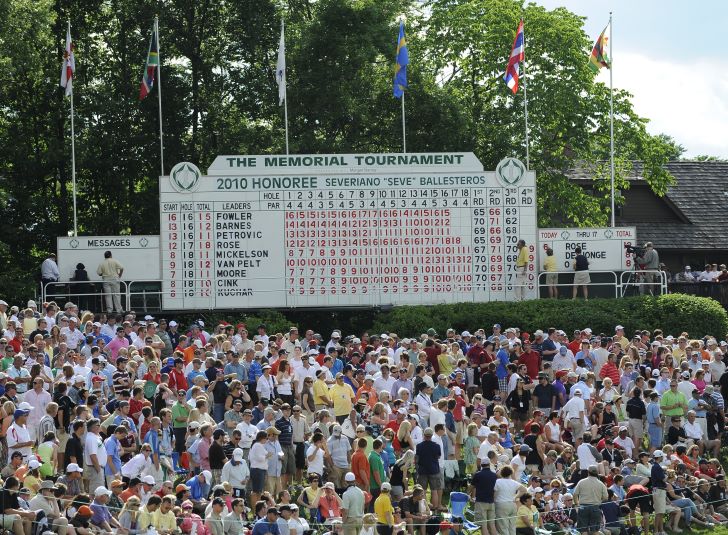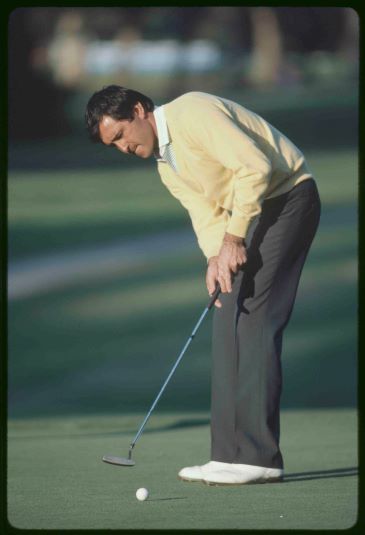 By Jim McCabe
By Jim McCabe
It is impossible to be cold at the Memorial Tournament at Muirfield Village. Not in early June when stifling humidity engulfs the Midwest.
But a lasting memory frozen in time? It happened right there at Jack Nicklaus’ famed club, no matter that temperatures were fixed in the 30s Celsius and sweat flowed excessively from a few dozen players who were grinding away on the range.
Until they stopped. In unison. Which is where the memory becomes frozen, an unforgettable sight that was a tribute to the aura of Seve Ballesteros.
It was June of 2010 and Ballesteros, then 53 and deep in the throes of a battle with cancer, offered his thanks to Nicklaus and his tournament committee for being that year’s Memorial Tournament Honoree. Unable to attend, the gallant Spaniard was shown via video that was displayed on large Jumbotrons, one of which was positioned at the range.
That is where players stopped working and watched in silence. Some of them had competed against Ballesteros, many of them had turned pro well after the great man’s career had ended, all of them had benefited from the magic he brought to the sport.
“He was an artist. The game played him,” David Feherty once said. “He was super-natural. I always felt he was still in control of the ball even when it was 200 yards away from him.”
Feherty, one year younger than Ballesteros, felt blessed to have played the European Tour at a time when the Spaniard helped carry it into prominence. Ballesteros was to Europe what Arnold Palmer was to the American PGA TOUR, a mystical figure whom fans adored, and sponsors lined up for.
Before Ballesteros the European Tour “was a bunch of gardeners,” said Feherty.
But riding Ballesteros’ charisma and his uncanny ability to hit a golf ball yards off-line, then find it, and figure out how to manufacture an impossible escape was the engine that drove the European Tour to a position of enormous strength in the 1980s and 1990s.
Not only did Ballesteros do magical things to win three Open Championships and two Masters, but he practically re-invented the Ryder Cup when Europeans were recruited to join their brethren from Great Britain and Ireland. He was someone you just could not take your eyes off.
Simply put, “he was a genius,” said Padraig Harrington. “And he loved the game.”
“There was an animal magnetism to him. Being with him was like being with a big cat; there was some sort of feline in him with his movements.”
Ballesteros had learned to play the game on the beach near his home in Pedrena, Spain. His upbringing was of mythical proportions, how he couldn’t afford good golf clubs, so his brother, Manual, gave him a hand-me-down 3-iron and Ballesteros learned to hit that one club a variety of different ways.
Low, high, curved left, or sliced right. Ballesteros loved the challenge, envisioned escape routes, invented stuff no one had ever imagined.
The secret was in the softest pair of hands the game has ever known. “He would hold a club so gently,” said Feherty, “like he was holding a day-old bird.”
He was a professional at 16, a rookie on the European Tour at 17, the Order of Merit winner at 19, the same year he introduced himself to the world by finishing tied for second with Jack Nicklaus behind Johnny Miller at the Open Championship.
It was the first time Nicklaus had ever seen him, but not the last. The Golden Bear was a confirmed fan. “His record, his charisma, his passion. He was great for the game,” Nicklaus said.
In 1979, at the tender age of 22, Ballesteros won the Open Championship at Royal Lytham in a fashion that typified him. Having somehow surged past Nicklaus, Hale Irwin and Ben Crenshaw, Ballesteros was in the lead when he drove it miles right at the par-4 17th. His ball caromed wildly into a car park, necessitating a free drop.
From the parking lot, Ballesteros hit a wedge to 15 feet and made birdie. “The Golf Gods,” declared the BBC announcer, “are with the smiling Spaniard today.”
The next year he won the Masters. And in 1984, arguably the tournament that completed his climb to the top of the mountain – an Open Championship at the home of golf, St. Andrews – Ballesteros produced an image that simply cannot be forgotten.
“The all-time greatest celebration,” declared Feherty of Ballesteros punching the air emphatically, a wide smile, and look of total joy on his face.
Four years later, again at Lytham, Ballesteros was brilliant. He shot a closing 65 and during a torrid 11-hole stretch made an eagle, six birdies, two pars and two bogeys, good enough to steal the Claret Jug right out from under Nick Price’s grip.
The Spaniard was just 31, seemingly at the height of his power, a five-time major winner. It’s unthinkable that he would never win another major, incomprehensible that his game would disappear as it did. Oh, there were some magical moments after Lytham ’88 – most of them in Ryder Cups, especially the confrontational episode with Paul Azinger in the 1991 classic at Kiawah Island.
But slowly and shockingly, his game left him. When he was just 38 years old, in 1995, he won his last tournament and more often than not the stories surrounding the proud Spaniard involved a man totally lost in his search to re-discover the magic.
“I don’t think he ever understood why he played so well,” said Feherty. “But when he tried to understand it, it didn’t work.”
Without his magical game, Ballesteros slid into the background. Not a recluse, mind you, because he always appreciated the power he seemed to have over people, but clearly Ballesteros became accustomed to his life out of the spotlight.
When his mission in life became not the challenge to deftly maneuver a ball along firm links turf between two bunkers and up close to the hole (a scintillating shot he pulled off at Birkdale in the 1976 Open) but to deal with cancer that had invaded his body, Ballesteros tried to call upon the pride and honor that blanketed his golf career.
He spoke graciously on many occasions, most memorably during his acceptance speech to fans gathered at Muirfield Village in 2010. The magical power he had brought to golf courses for nearly 20 years was flashed one last time, for Ballesteros did the unthinkable.
He made players stop hitting balls and hang on his every word.
His life would end one year later, in May of 2011. His legend lives on.



































